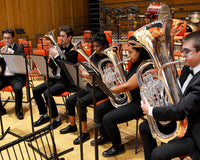It is every drummer’s worst nightmare that something may break or be forgotten at a live gig. This is exactly why it is essential to carry a survival kit with you wherever you play. I have detailed below what I take with me to every event in case of a last minute emergency such as a split skin or a out of tune tom.
1. Felts and Plastic Sleeves
You can never carry enough cymbal felts with you wherever you perform. They are the one thing every drummer will loose countless amounts of. Whether they are lost or stolen, these little things are an essential part to your performance. They make sure your cymbals can resonate to their full potential.
Another key factor to a great cymbal sound - and also most likely to go missing with the felts are the cymbal sleeves. They add support to the cymbals when balancing on the stands and stop them from over wobbling when you hit them.
2. Drum Key
Your drum key is the most essential part to the survival kit. If your kit gets knocked out of tune in transit then you are always prepared to tune the skins when needed. Sometimes if you have a new skin on you will need a drum key on you all the time - if you are playing heavily in a set then it is likely that the tune will keep dropping to start off with. It is also there for you if you break a skin - having a decent drum key can mean a quick skin change during the slow songs or interval. There is nothing worse than these things happening!
3. Spare Drum Sticks
When you play a gig - you can never take too many drum sticks. Grab yourself a drum stick bag and load it with all the different types. I personally have 1 pair of sticks I use for every gig - but in the likely event that they will some day break whilst playing, I carry at least 2 spares along with my variety of sticks to be on the safe side. It's a great idea to have a bag as well, this can be where you keep all your extra drum kit parts so they are not scattered about. Also, have a selection of sticks like hot rods and brushes with you in case you end up playing in a quieter environment than you expected.
4. Drum Heads
There is nothing worse than breaking a drum skin when you are playing a gig. You can be cautious and take a spare skin for every drum - however it's a lot of spares and can be quite expensive. Drum skins don't break too often, but when they do it's never the place you want it to happen. Think logically, which two drums are the biggest part of your performance? Your snare and bass drum! So, keep one of each with you just in case, and a big roll of gaffa tape for if a tom breaks, you can tape it back up till you get home!
5. Drum Cases
It is important you protect your drum kit, especially if you are travelling and transporting it a lot. It will stop any silly little damages happening like a lot of things mentioned above. When you set out to spend a lot of money on a drum kit the last thing you want is to have it looking like an old tatty one not long after you start playing it. Yes, you need to let it have character over the years but not so much it can ruin your drum kit tone and appearance drastically. Gigbags and cases are very important to keep things protected.
Other spares to have:
- Bass Drum - either a spare pedal or spare springs (they are the most likely thing to break and the cheapest to replace).
- Hi-Hat Clutch - in case you lose it or the threads go on it.
- Cymbal stands - this is especially important if you are only taking breakables to a gig, you might need your own if they don't use as many as you.
- Snare string - If your snare wires stop working you can replace the string quickly without having a snare-less performance.
If you need any more survival tips then please feel free to contact us and we will be happy to help and answer any queries you have.















